文章目录
- 1.注解的概述
- 2.常见的Annotation示例
- 2.1 生成文档相关的注解
- 2.2 在编译时进行格式检查的注解
- 2.3 跟踪代码依赖性,实现替代配置文件功能的注解
- 3.自定义Annotation
- 4.JDK中的元注解
- 4.1 Retention
- 4.2 Target
- 4.3 Documented & Inherited
- 5. JDK8中注解的新特性
- 5.1 可重复注解
- 5.2 类型注解
1.注解的概述
Annotation(注解)是 JDK 5.0时加的新特性。 从 JDK 5.0 开始, Java 增加了对元数据(MetaData) 的支持, 也就是 Annotation(注解) 。
Annotation 其实就是代码里的特殊标记 , 这些标记可以在编译, 类加载, 运行时被读取, 并执行相应的处理。通过使用Annotation, 程序员可以在不改变原有逻辑的情况下, 在源文件中嵌入一些补充信息。代码分析工具、开发工具和部署工具可以通过这些补充信息进行验证或者进行部署。
Annotation 可以像修饰符一样被使用, 可用于修饰包,类, 构造器, 方法, 成员变量, 参数, 局部变量的声明, 这些信息被保存在 Annotation 的 “name=value” 对中。
在JavaSE中,注解的使用目的比较简单,例如标记过时的功能, 忽略警告等。在JavaEE/Android中注解占据了更重要的角色,例如 用来配置应用程序的任何切面,代替JavaEE旧版中所遗留的繁冗代码和XML配置等。
未来的开发模式都是基于注解的,JPA是基于注解的,Spring2.5以 上都是基于注解的,Hibernate3.x以后也是基于注解的,现在的 Struts2有一部分也是基于注解的了,注解是一种趋势,一定程度上 可以说:框架 = 注解 + 反射 + 设计模式。
2.常见的Annotation示例
使用 Annotation 时要在其前面增加 @ 符号, 并把该 Annotation 当成 一个修饰符使用。用于修饰它支持的程序元素。
2.1 生成文档相关的注解
| 注解名 | 作用 | 格式要求 |
|---|---|---|
| @author | 标明开发该类模块的作者,多个作者之间使用,分割 | ——— |
| @version | 标明该类模块的版本 | ——— |
| @see | 参考转向,也就是相关主题 | ——— |
| @since | 从哪个版本开始增加的 | ——— |
| @param | 对方法中某参数的说明,如果没有参数就不能写 | @param 形参名 形参类型 形参说明 |
| @return | 对方法返回值的说明,如果方法的返回值类型是void就不能写 | @return 返回值类型 返回值说明 |
| @exception | 对方法可能抛出的异常进行说明 ,如果方法没有用throws显式抛出的异常就不能写 | @exception 异常类型 异常说明 |
其中: 1. @param @return 和 @exception 这三个标记都是只用于方法的。
2. @param和@exception可以并列多个。
下面给出一个实例体会一下:
package com.annotation.javadoc;/*** @author shkstart* @version 1.0* @see Math.java*/public class JavadocTest {/*** 程序的主方法,程序的入口* @param args String[] 命令行参数*/public static void main(String[] args) {}/*** 求圆面积的方法* @param radius double 半径值* @return double 圆的面积*/public static double getArea(double radius){return Math.PI * radius * radius;}
}
在上述的例子当中,除了表格中的 @since 和 @exception 两个没有用到外,其余的生成文档相关的注解都已经使用过了。
2.2 在编译时进行格式检查的注解
在这一部分中,JDK内置了三个基本的注解,分别为: @Override 、@Deprecated 和 @SuppressWarnings 。
| @Override | 限定重写父类方法, 该注解只能用于方法 |
|---|---|
| @Deprecated | 用于表示所修饰的元素(类, 方法等)已过时。通常是因为 所修饰的结构危险或存在更好的选择 |
| @SuppressWarnings | 抑制编译器警告 |
下面分别给出它们的使用:
- @Override的使用
class Person{private String name;private int id;public Person() {}public Person(String name, int id) {this.name = name;this.id = id;}public void walk(){System.out.println("人走路");}public void eat(){System.out.println("人吃饭");}}class Student extends Person{@Override //在编译时检查一下这个walk方法是不是重写父类的(如果不是,就会给出报错的提示)public void walk() {System.out.println("学生走路");}}
在上述代码块中,我们先是定义了一个Person类,在声明了两个属性,提供了构造器后提供了两个方法walk()和eat(); 接着定义了一个Student类去继承Person类,并重写了walk方法。
下面我们给出测试:
public class AnnotationTest {public static void main(String[] args) {Person p = new Student();p.walk();}}
测试结果如下:

使用 @Override 的好处是它会在编译时检查一下这个walk方法是不是重写父类的,如果重写walk方法写的是对的,那么不使用 @Override 也没有什么影响,编译器只是不会帮你检查了,但效果是一样的。如果写错了,它就会给出报错的提示。比如walk拼写错误,把字母l写成了数字1,那么在编译时就过不去。如下图所示:

2.@Deprecated的使用
加上了@Deprecated 修饰的结构表示时已经过时了,但是过时了的东西还是可以用的,只是不建议使用。
public class AnnotationTest {public static void main(String[] args) {// 这个构造器就是已经过时了,但是过时了的东西还是可以用的Date date = new Date(2020, 10, 11);System.out.println(date);}
}
上述代码块中的Date类的构造器就已经过时了,API文档的解释如下:
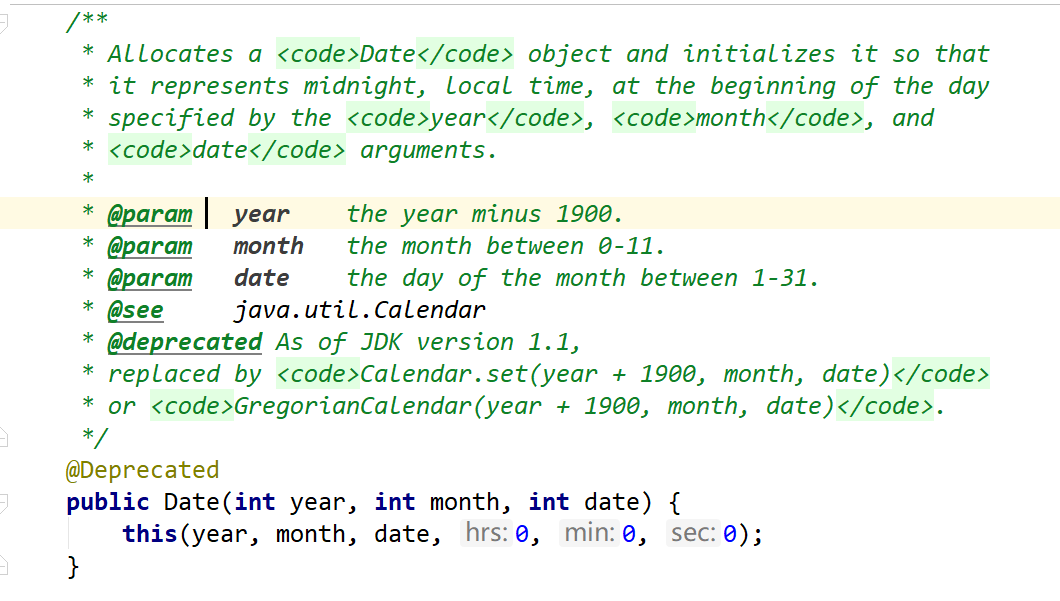
3.@SuppressWarnings的使用
@SuppressWarnings的作用是抑制编译器的警告,比如我们在程序中定义了一个变量,但是目前还没有使用过,此时编译器就会报一个 ‘unused’ 的警告。这个在eclipse中表现的更加明显。如下所示:
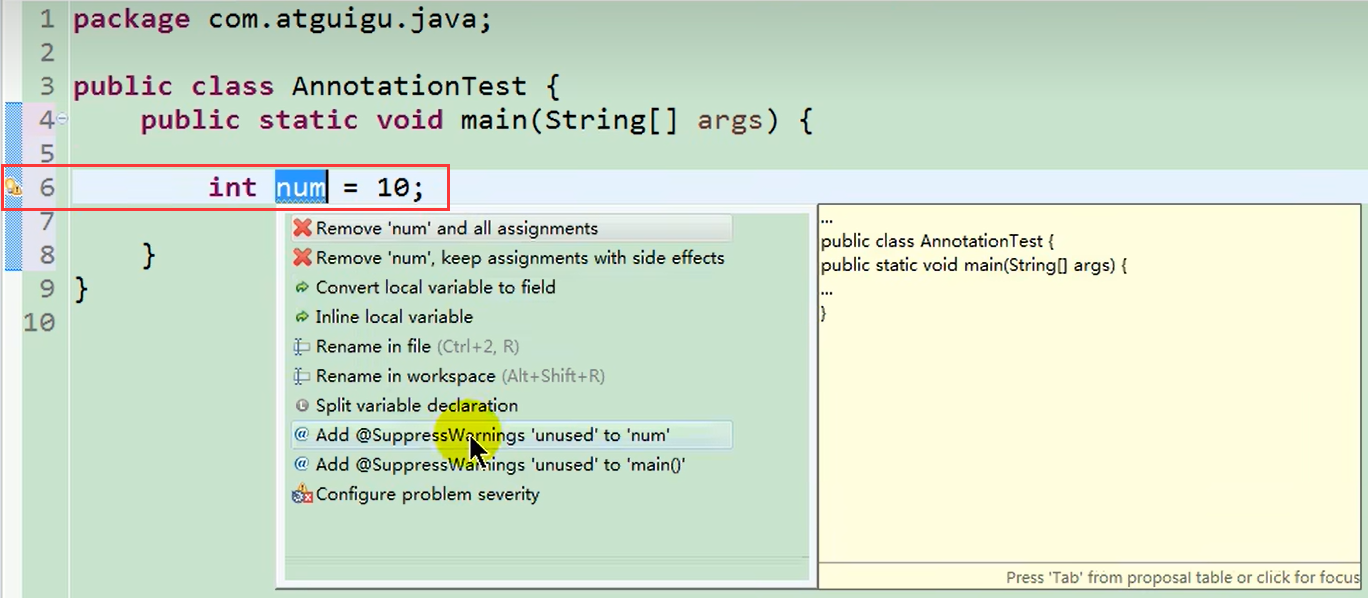
在main方法中我们定义了一个整型变量num,但未使用,此时就会在函数的左边出现黄色的警告。

在这个变量上添加 @SuppressWarnings(“unused”) 的注解后,左边的警告就消失了。
需要注意的是:@SuppressWarnings() 的参数部分可以写多个值,也就是可以抑制多个警告。这是因为它的成员变量是一个字符串数组。API 如下图所示:
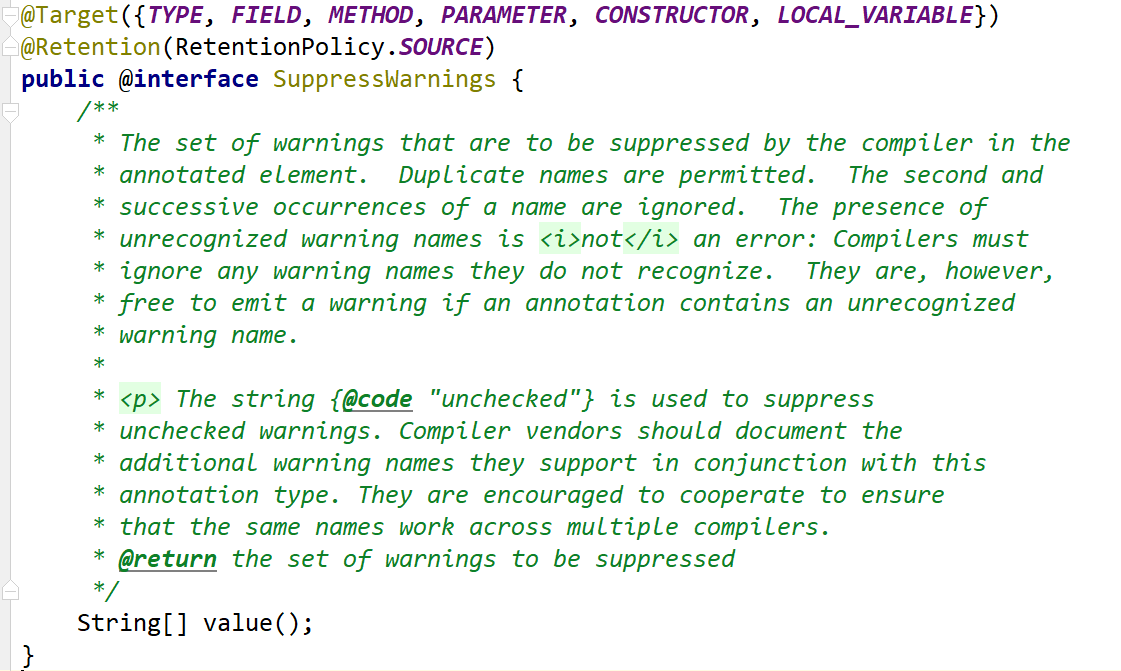
2.3 跟踪代码依赖性,实现替代配置文件功能的注解
举出如下的两个例子来说明一下:
Servlet3.0提供了注解(annotation),使得不再需要在web.xml文件中进行Servlet的部署。
public class LoginServlet extends HttpServlet {private static final long serialVersionUID = 1L;protected void doGet(HttpServletRequest request, HttpServletResponse response) throwsServletException, IOException { }protected void doPost(HttpServletRequest request, HttpServletResponse response) throwsServletException, IOException {doGet(request, response);}
}
要想在客户端输入/login时执行这个Servlet 内的业务逻辑,需要写配置文件作映射,如下所示:
<servlet>
<servlet-name>LoginServlet</servlet-name>
<servlet-class>com.servlet.LoginServlet</servlet-class>
</servlet>
<servlet-mapping>
<servlet-name>LoginServlet</servlet-name>
<url-pattern>/login</url-pattern>
</servlet-mapping>
而有了注解后只需为该Servlet添加一个@WebServlet即可:
@WebServlet("/login")
public class LoginServlet extends HttpServlet {private static final long serialVersionUID = 1L;protected void doGet(HttpServletRequest request, HttpServletResponse response) throwsServletException, IOException { }protected void doPost(HttpServletRequest request, HttpServletResponse response) throwsServletException, IOException {doGet(request, response);}
}
Spring框架关于事务的管理:
在原来需要使用配置文件指明事务的管理情况,现在可以把这些信息体现为注解,不需要再去写xml文件了。
@Transactional(propagation=Propagation.REQUIRES_NEW,isolation=Isolation.READ_COMMITTED,readOnly=false,timeout=3)public void buyBook(String username, String isbn) {//1.查询书的单价int price = bookShopDao.findBookPriceByIsbn(isbn);//2. 更新库存bookShopDao.updateBookStock(isbn);//3. 更新用户的余额bookShopDao.updateUserAccount(username, price);
}
<!-- 配置事务属性 -->
<tx:advice transaction-manager="dataSourceTransactionManager" id="txAdvice">
<tx:attributes>
<!-- 配置每个方法使用的事务属性 -->
<tx:method name="buyBook" propagation="REQUIRES_NEW"
isolation="READ_COMMITTED" read-only="false" timeout="3" />
</tx:attributes>
</tx:advice>
3.自定义Annotation
注解也可以自定义,就像自定义类、接口、异常一样。如果现有的注解不能够满足我们的需求,那么我们也可以自定义注解。
如何自定义注解?
我们仿照 SuppressWarnings 自定义一个注解,先来看一下 SuppressWarnings 的结构:
package java.lang;
import java.lang.annotation.*;
import static java.lang.annotation.ElementType.*;/*** Indicates that the named compiler warnings should be suppressed in the* annotated element (and in all program elements contained in the annotated* element). Note that the set of warnings suppressed in a given element is* a superset of the warnings suppressed in all containing elements. For* example, if you annotate a class to suppress one warning and annotate a* method to suppress another, both warnings will be suppressed in the method.** <p>As a matter of style, programmers should always use this annotation* on the most deeply nested element where it is effective. If you want to* suppress a warning in a particular method, you should annotate that* method rather than its class.** @author Josh Bloch* @since 1.5* @jls 4.8 Raw Types* @jls 4.12.2 Variables of Reference Type* @jls 5.1.9 Unchecked Conversion* @jls 5.5.2 Checked Casts and Unchecked Casts* @jls 9.6.3.5 @SuppressWarnings*/
@Target({TYPE, FIELD, METHOD, PARAMETER, CONSTRUCTOR, LOCAL_VARIABLE})
@Retention(RetentionPolicy.SOURCE)
public @interface SuppressWarnings {/*** The set of warnings that are to be suppressed by the compiler in the* annotated element. Duplicate names are permitted. The second and* successive occurrences of a name are ignored. The presence of* unrecognized warning names is <i>not</i> an error: Compilers must* ignore any warning names they do not recognize. They are, however,* free to emit a warning if an annotation contains an unrecognized* warning name.** <p> The string {@code "unchecked"} is used to suppress* unchecked warnings. Compiler vendors should document the* additional warning names they support in conjunction with this* annotation type. They are encouraged to cooperate to ensure* that the same names work across multiple compilers.* @return the set of warnings to be suppressed*/String[] value();
}从 Annotation 的定义中可以看出:
1.注解声明为 @interface ,即自定义注解需要使用这个关键字。
2.自定义注解自动继承了 java.lang.annotation.Annotation 接口。
3. Annotation 的成员变量在 Annotation 定义中以无参数方法的形式来声明。其方法名和返回值定义了该成员的名字和类型。我们称为配置参数。类型只能是八种基本数据类型、String类型、Class类型、enum类型、Annotation类型、 以上所有类型的数组。
(在 SuppressWarnings 中声明的是一个String类型的数组,因为该注解有多个成员变量)
4. 可以在定义 Annotation 的成员变量时为其指定初始值, 指定成员变量的初始值使用 default 关键字。
5. 如果只有一个参数成员,建议使用参数名为 value。
6. 如果定义的注解含有配置参数,那么使用时必须指定参数值,除非它有默认 值。格式是“参数名 = 参数值” ,如果只有一个参数成员,且名称为value, 可以省略“value=”。
7.如果自定义的注解没有成员,表明是一个标识作用。可以类比一下 io 流中的Serializable 接口(一个没有抽象方法的接口,只是起到一个标志的作用)。比如:@override这个注解里就是没有成员的。
下面我们自定义一个名为 MyAnnotation 的注解:
/*
* 注:@interface 和 interface 没有任何的关系
* */
public @interface MyAnnotation {String value(); //若有多个成员变量时可以指定成数组}
然后我们就可以使用这个注解了,这里我们把它添加到Person类上。如下所示:
@MyAnnotation(value = "kaixuan")
class Person{private String name;private int id;public Person() {}public Person(String name, int id) {this.name = name;this.id = id;}public void walk(){System.out.println("人走路");}public void eat(){System.out.println("人吃饭");}}
有几点需要注意:
1.value 是MyAnnotation 的成员变量的值,必须要给它指定了,不然会value丢失的错。
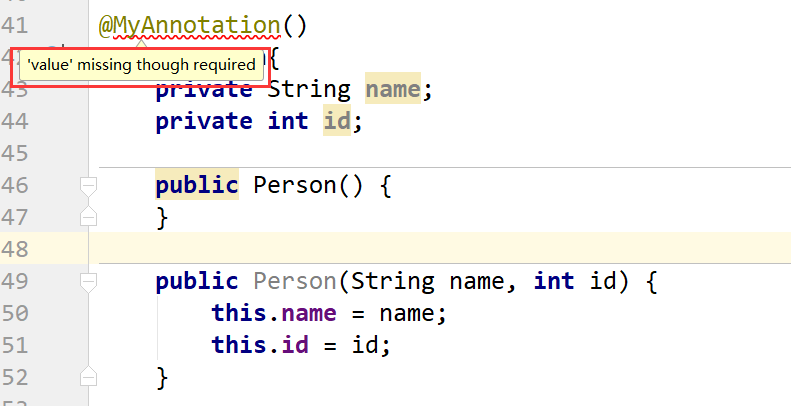
2.如果不想在使用的地方指定,也可以在声明 MyAnnotation 时为 value 指定一个默认的值。
public @interface MyAnnotation {String value() default "dabing"; //若有多个成员变量时可以指定成数组
}
当然默认指定的优先级一定是低于添加注解时指定的value值的。
3.自定义注解必须配上注解的信息处理流程(使用反射)才有意义。
4.JDK中的元注解
JDK 的元注解用于修饰其他 Annotation 定义。也就是说:元注解是对现有的注解进行解释说明的注解。
以"元数据"的解读来类比一下,比如现在有一个字符串类型的数据如下:
String name = "kaixuan";
显然,这里的数据是"kaixuan",是程序中要使用到的数据。而其余两部分“String”和“name”是用来修饰这个数据的,“String”指明了这个数据的类型是字符串;“name”是给这个数据起了个名字。所以这两个修饰"kaixuan"的数据String和name 就被称为"元数据"。理解了元数据,那么元注解也就不难理解了吧。
JDK5.0提供了4个标准的meta-annotation类型,分别是:Retention、Target、Documented 和 Inherited。各自的作用如下表所示:
| Retention | 指定所修饰的Annotation的生命周期:SOURCE / CLASS(默认行为) / RUNTIME
(只有声明为RUNTIME生命周期的注解,才能通过反射获取。) |
| — | — |
| Target | 用于指定被修饰的Annotation能用于修饰哪些程序元素 |
| Documented | 用于指定被该元 Annotation 修饰的注解在被javadoc解析时,保留下来。 |
| Inherited | 被它修饰的Annotation将具有继承性。如果某个类使用了@Inherited修饰的注解,则其子类将自动具有该注解。 |
4.1 Retention
该注解只能用于修饰一个 Annotation 定义, 用于指定该 Annotation 的生命周期。
如何实现指定Annotation 生命周期?
@Rentention 包含一个 RetentionPolicy 类型的成员变量, 而这个RetentionPolicy本身又是枚举类型的,其中包含三个值:SOURCE,CLASS, RUNTIME。
Retention注解源码如下:
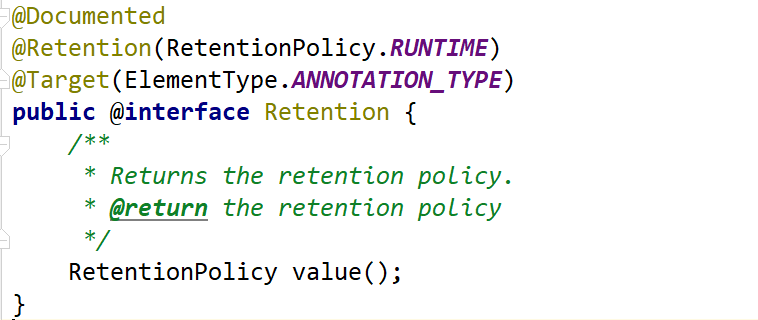
RetentionPolicy 枚举类如下:
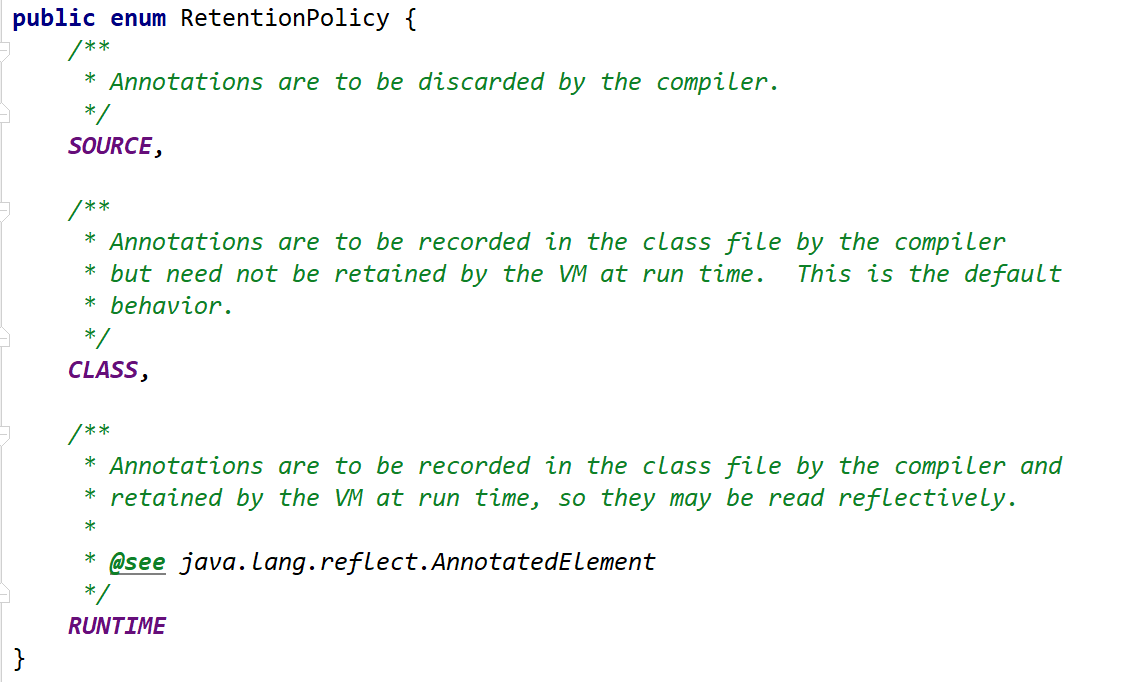 下面说一下这三个值的作用:
下面说一下这三个值的作用:
| RetentionPolicy.SOURCE | 在源文件中有效(即源文件保留),编译器直接丢弃这种策略的注释。也就是说在执行javac命令后,生成的.class文件中不会保留注解的信息 |
|---|---|
| RetentionPolicy.CLASS | 在class文件中有效(即class保留) , 当运行 Java 程序时, JVM 不会保留注解。 这是默认值 |
| RetentionPolicy.RUNTIME | 在运行时有效(即运行时保留),当运行 Java 程序时, JVM 会 保留注释。程序可以通过反射获取该注释。 |
| (会被保存在.class文件里面,且解释运行的时候还会加载进内存里,所以是可以通过反射去读取的。) |
所以只有声明为 RUNTIME 生命周期的注解,才能通过反射获取。
下面我们给刚才自定义的注解MyAnnotation 加上Retention,并把内部的RetentionPolicy 成员的值指定为 RUNTIME 来做一下测试:
import java.lang.annotation.Retention;
import java.lang.annotation.RetentionPolicy;@Retention(RetentionPolicy.RUNTIME)
public @interface MyAnnotation {String value() default "dabing"; //若有多个成员变量时可以指定成数组}
这样设计后就可以在运行时获取到这个注解信息了。把MyAnnotation添加到Person类上,由于MyAnnotation里已经给出了默认的value值就不再指定。
@MyAnnotation()
class Person{private String name;private int id;public Person() {}public Person(String name, int id) {this.name = name;this.id = id;}public void walk(){System.out.println("人走路");}public void eat(){System.out.println("人吃饭");}}
然后我们通过反射来获取一下Person类上的注解信息,给出如下的测试:
@Test
public void test1() {Class clazz = Person.class;Annotation[] annotations = clazz.getAnnotations();for (Annotation a : annotations) {System.out.println(a);}
}
测试结果如下:

4.2 Target
用于修饰 Annotation 定义, 用于指定被修饰的 Annotation 能用于修饰哪些程序元素。 @Target 也包含一个名为 value 的成员变量。
查看一下Target的源码:
package java.lang.annotation;
@Documented
@Retention(RetentionPolicy.RUNTIME)
@Target(ElementType.ANNOTATION_TYPE)
public @interface Target {/*** Returns an array of the kinds of elements an annotation type* can be applied to.* @return an array of the kinds of elements an annotation type* can be applied to*/ElementType[] value();
}
可以看到,它里面的value是一个ElementType类型的数组,深入查看 value 数组如下:
package java.lang.annotation;public enum ElementType {/** Class, interface (including annotation type), or enum declaration */TYPE,/** Field declaration (includes enum constants) */FIELD,/** Method declaration */METHOD,/** Formal parameter declaration */PARAMETER,/** Constructor declaration */CONSTRUCTOR,/** Local variable declaration */LOCAL_VARIABLE,/** Annotation type declaration */ANNOTATION_TYPE,/** Package declaration */PACKAGE,/*** Type parameter declaration** @since 1.8*/TYPE_PARAMETER,/*** Use of a type** @since 1.8*/TYPE_USE
}
可以看到,这也是一个枚举类,内部定义了十个常量,分别代表什么注释中已经写的很清楚了。
下面再看一下 Target 对 SuppressWarnings 的修饰:
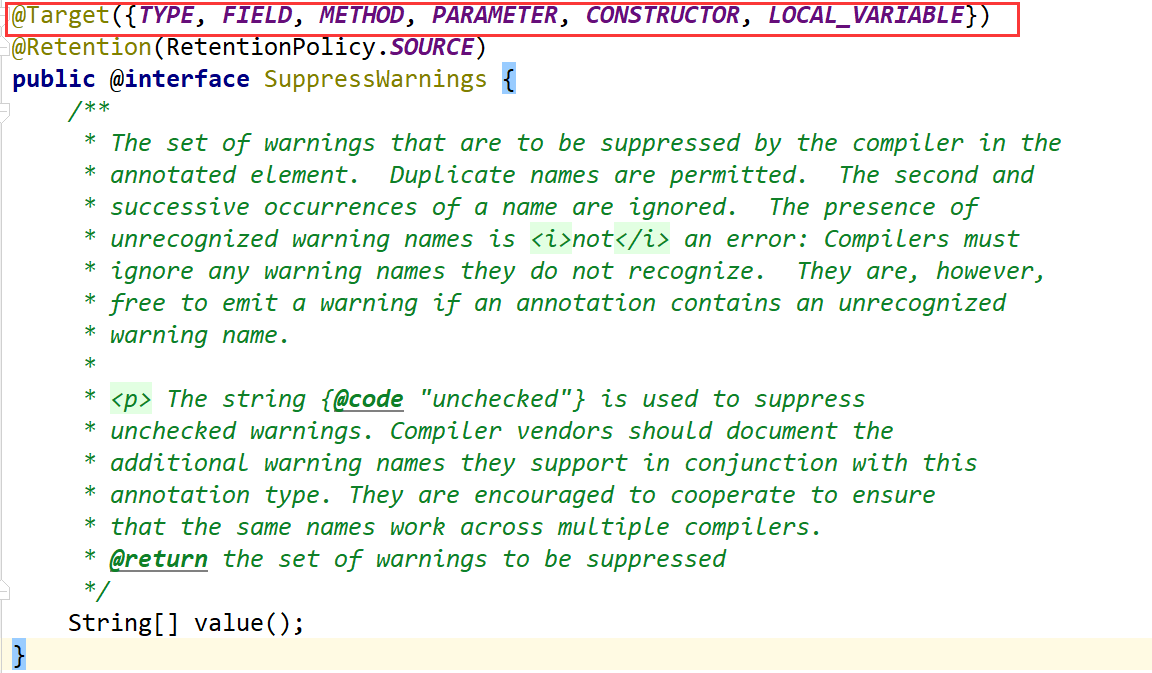
很显然,Target 指定了SuppressWarnings 可以作用的六种类型,也就是说只有在这几类结构上面是可以添加 SuppressWarnings 注解的,而其他的结构不行。我们也可以为刚才自定义的MyAnnotation添加元注解Target,指明MyAnnotation 可以修饰哪些结构。
import java.lang.annotation.Retention;
import java.lang.annotation.RetentionPolicy;
import java.lang.annotation.Target;import static java.lang.annotation.ElementType.*;
import static java.lang.annotation.ElementType.CONSTRUCTOR;
import static java.lang.annotation.ElementType.LOCAL_VARIABLE;@Target({TYPE, FIELD, METHOD, PARAMETER, CONSTRUCTOR, LOCAL_VARIABLE})
@Retention(RetentionPolicy.RUNTIME)
public @interface MyAnnotation {String value() default "dabing"; //若有多个成员变量时可以指定成数组}
自定义注解通常都会指明两个元注解:Retentino、Target。
4.3 Documented & Inherited
Documented : 用于指定被该元 Annotation 修饰的注解在被javadoc解析时,保留下来。默认情况下,javadoc是不包括注解的。( 定义为Documented的注解必须设置Retention值为RUNTIME。 )
Inherited :它修饰的Annotation将具有继承性。如果某个类使用了@Inherited 修饰的注解,则其子类将自动具有该注解。
下面给出Inherited注解的测试:
首先为MyAnnotation注解添加Inherited 元注解:
import java.lang.annotation.Inherited;
import java.lang.annotation.Retention;
import java.lang.annotation.RetentionPolicy;
import java.lang.annotation.Target;import static java.lang.annotation.ElementType.*;
import static java.lang.annotation.ElementType.CONSTRUCTOR;
import static java.lang.annotation.ElementType.LOCAL_VARIABLE;@Inherited
@Target({TYPE, FIELD, METHOD, PARAMETER, CONSTRUCTOR, LOCAL_VARIABLE})
@Retention(RetentionPolicy.RUNTIME)
public @interface MyAnnotation {String value() default "dabing"; //若有多个成员变量时可以指定成数组}
在Person类上使用MyAnnotation注解,并指定其中的value值为"kaixuan",Student为Person的子类,不添加注解:
import org.junit.Test;
import java.lang.annotation.Annotation;@MyAnnotation("kaixuan") //value是MyAnnotation的成员变量的值,必须要给它指定了,不然会报错。也可以在声明注解时给出value的默认值
class Person{private String name;private int id;public Person() {}public Person(String name, int id) {this.name = name;this.id = id;}public void walk(){System.out.println("人走路");}public void eat(){System.out.println("人吃饭");}}interface Info{void show();
}class Student extends Person implements Info{@Override //在编译时检查一下这个walk方法是不是重写父类的(如果不是,就会给出报错的提示)public void walk() {System.out.println("学生走路");}@Override //实现接口中的抽象方法public void show() {}
}
给出测试程序,验证 Student 类上是否有MyAnnotation注解:
@Testpublic void testGetAnnotation(){Class clazz = Student.class;Annotation[] annotations = clazz.getAnnotations();for(Annotation a : annotations){System.out.println(a);}}
测试结果如下:

可以看到,Student类上的MyAnnotation和其父类中的是一样的。
5. JDK8中注解的新特性
Java 8 对注解处理提供了两点改进:可重复的注解及可用于类型的注解。
5.1 可重复注解
如果希望一个注解可以在一个结构(类、接口、属性、方法…)上同时使用多次,那么这个注解就被称为“重复注解”。
比如说现在想要把我们自定义的 MyAnnotation 注解在Person类上使用两次,如下所示:
@MyAnnotation("kaixuan")
@MyAnnotation("runze")
class Person{private String name;private int id;public Person() {}public Person(String name, int id) {this.name = name;this.id = id;}public void walk(){System.out.println("人走路");}public void eat(){System.out.println("人吃饭");}
}
但是这个时候肯定是会报错的,如下图所示:

这是因为MyAnnotation 只能赋一次值,使用之后就没了不能再用了。要想实现这个功能,只能再声明一个value值为 MyAnnotation类型的数组 的新的注解,使用这个注解完成这个功能。比如声明为MyAnnotations,设计如下:
public @interface MyAnnotations {MyAnnotation[] value();
}
接着在Person类上添加MyAnnotations 注解,形式如下:

上述的做法是jdk 8之前的写法,那么在jdk 8 引入了可重复注解之后,可以怎么实现呢?
首先我们需要为 MyAnnotation 注解添加一个元注解 Repeatable,并传入一个Class实例,也就是一个运行时类,这里我们传入MyAnnotations.class。Repeatable注解的源码如下:
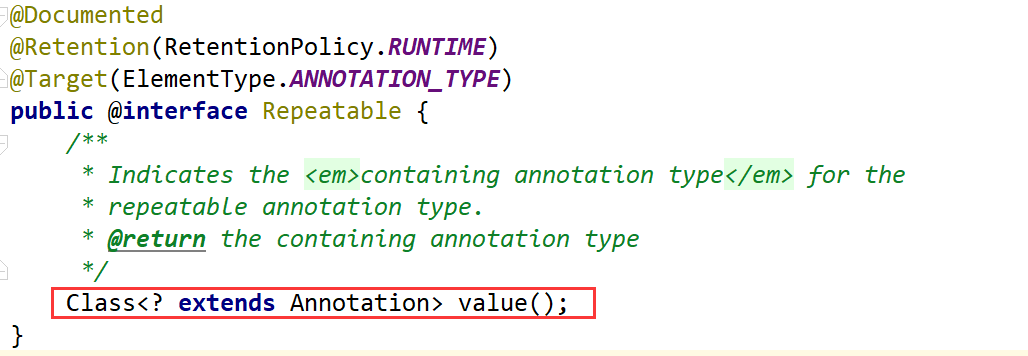
可见,Repeatable注解的value值类型为Class的实例。
接着我们把MyAnnotations 和 MyAnnotation 的生命周期Retention、所作用的结构Target 以及Inherited都保持一致。
最终的MyAnnotation设计如下:
import java.lang.annotation.*;import static java.lang.annotation.ElementType.*;
import static java.lang.annotation.ElementType.CONSTRUCTOR;
import static java.lang.annotation.ElementType.LOCAL_VARIABLE;//在MyAnnotation中使用MyAnnotations,所以要求MyAnnotations的生命周期不能小于MyAnnotation,避免出现当要使用;
//的时候,MyAnnotations不可用;而作用的对象也是一样的道理,将它们的作用对象保持一致即可。
@Inherited
@Repeatable(MyAnnotations.class)
@Target({TYPE, FIELD, METHOD, PARAMETER, CONSTRUCTOR, LOCAL_VARIABLE})
@Retention(RetentionPolicy.RUNTIME)
public @interface MyAnnotation {String value() default "dabing"; //若有多个成员变量时可以指定成数组
}
MyAnnotations设计如下:
import java.lang.annotation.Inherited;
import java.lang.annotation.Retention;
import java.lang.annotation.RetentionPolicy;
import java.lang.annotation.Target;import static java.lang.annotation.ElementType.*;
import static java.lang.annotation.ElementType.CONSTRUCTOR;
import static java.lang.annotation.ElementType.LOCAL_VARIABLE;@Inherited
@Retention(RetentionPolicy.RUNTIME)
@Target({TYPE, FIELD, METHOD, PARAMETER, CONSTRUCTOR, LOCAL_VARIABLE})
public @interface MyAnnotations {MyAnnotation[] value();
}
这个时候就可以实现在Person类上多次使用MyAnnotation了。

可以看到,写成最开始的需求也不会报错了。
5.2 类型注解
JDK 8之后,关于元注解@Target的参数类型ElementType枚举值多了两个: TYPE_PARAMETER,TYPE_USE。
在Java 8之前,注解只能是在声明的地方所使用,Java8开始,注解可以应用 在任何地方。
| ElementType.TYPE_PARAMETER | 表示该注解能写在类型变量的声明语 句中(如:泛型声明)。 |
|---|---|
| ElementType.TYPE_USE | 表示该注解能写在使用类型的任何语句中。 |
下面给出测试:
//使用注解修饰泛型的类型
class Generic<@MyAnnotation T>{public void show() throws @MyAnnotation RuntimeException {//使用注解修饰别的任何语句ArrayList<@MyAnnotation String> list = new ArrayList<>();int num = (@MyAnnotation int) 10L;}
}
同时需要为MyAnnotation注解的Target元注解添加TYPE_PARAMETER和TYPE_USE。
@Inherited
@Repeatable(MyAnnotations.class)
@Target({TYPE, FIELD, METHOD, PARAMETER, CONSTRUCTOR, LOCAL_VARIABLE, TYPE_PARAMETER,TYPE_USE})
@Retention(RetentionPolicy.RUNTIME)
public @interface MyAnnotation {String value() default "dabing"; //若有多个成员变量时可以指定成数组
}


)







)

)
)



】:用邻接矩阵和邻接表实现图)

